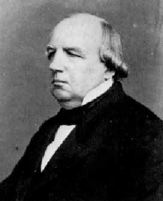

Karl Weierstrass's father became a tax inspector when Karl was eight years old. This job involved him in only spending short periods in any one place so Karl
frequently moved from school to school as the family moved around Prussia. In 1829, Weierstrass entered the Gymnasium in Paderborn. Weierstrass excelled at the Gymnasium despite having to take on a part-time job as a bookkeeper to help out the family finances.
Though Weierstrass showed promise in mathematics, his father wished him to study finance. So after graduating from the Gymnasium in 1834, he entered the University of Bonn with a course planned out for him which included the study of law, finance and economics.
Weierstrass was torn between the subject he loved and the subject his father wanted for him, and he spent 4 years of intensive fencing and drinking.
He did study mathematics on his own, however, reading works by Laplace, Jacobi, Guderman, Abel, and Lie. Eventually, Weierstrass made the decision to become a mathematicianHe convinced his father to let him study at the Theological and Philosophical Academy of Münster so
that he could take the necessary examinations to become a secondary school teacher.
There he attended Gudermann's lectures on elliptic functions, some of the first lectures on this topic to be given, and Gudermann strongly
encouraged Weierstrass in his mathematical studies.
In 1841, Weierstrass had taken the necessary oral examinations and he began as a teacher. He wrote three short papers in 1841 and 1842 which contained the concepts on which he based his theory of functions of a complex variable in later years. He taught at various schools in Germany. As a teacher of mathematics he was required to teach other topics too, and he taught physics, botany, geography, history, German, calligraphy and even gymnastics.
In 1854 he published a paper on abelian functions. This paper did not give the full theory of inversion of hyperelliptic integrals that Weierstrass had developed but rather gave a preliminary description of his methods involving representing
abelian functions as constantly converging power series.
With this paper Weierstrass burst from obscurity. The University of Königsberg conferred an honorary doctor's degree on him in 1854.
After being promoted to senior lecturer at Braunsberg, Weierstrass obtained a year's leave of absence to devote himself to advanced mathematical study. He
had already decided, however, that he would never return to school teaching.
Weierstrass published a full version of his theory of inversion of hyperelliptic integrals in his next paper in 1856. Now there was a move from a number of universities to offer him a chair, and he accepted one from the Industry Institute in Berlin, follwed quickly by one at the University of Berlin.
Weierstrass's successful lectures in mathematics attracted students from all over the world. The topics of his lectures included the application of Fourier
series and integrals to mathematical physics, an introduction to the theory of analytic functions, the theory of elliptic functions, applications to problems in geometry and mechanics, the foundations of analysis, and the integral calculus. In 1861 his emphasis on rigour led him to discover a function that, although continuous, had no derivative at any point.
Weierstrass suffered from health problems from 1850 onwards, and in 1861 he collapsed completely. It took him about a year to recover sufficiently to lecture again and he was never to regain his health completely. From this time on, he lectured sitting down with a student wrote on the blackboard for him.
In his 1863-64 course on "The general theory of analytic functions", Weierstrass began to formulate his theory of the real numbers. In his 1863 lectures he
proved that the complex numbers are the only commutative algebraic extension of the real numbers. Gauss had promised a proof of this in 1831 but had failed to give one.
Weierstrass's lectures developed into a 4-semester course which he continued to give until 1890. The courses were "Introduction to the theory of analytic functions", "Elliptic functions","Abelian functions", and "Calculus of variations or applications of elliptic functions".
Weierstrass's approach still dominates teaching analysis today, and this is clearly seen from the contents and style of these lectures, particularly the introduction course.
At Berlin Weierstrass had two exceptional colleagues, Kummer and Kronecker, and together the three gave Berlin a reputation as the leading university at which to study mathematics.
A large number of students benefited from Weierstrass's teaching. We name a few: Bachmann, Bolza, Cantor, Engel, Frobenius, Gegenbauer, Hensel, Höder, Hurwitz, Killing, Klein, Kneser, Königsberger, Lerch, Lie, Lueroth, Mertens, Minkowski, Mittag-Leffler, Netto,
Schottky, Schwarz and Stolz.
The standards of rigour that Weierstrass set strongly affected the future of
mathematics. He also studied entire functions, the notion of uniform convergence and functions defined by infinite products. Known as the father of modern analysis, Weierstrass devised tests for the convergence of series and contributed to the theory of periodic functions, functions of real variables, elliptic functions, Abelian functions, converging infinite products, and the calculus of variations. He also advanced the theory of bilinear and quadratic forms.
Weierstrass published relatively little. However, he did edit the complete works of Steiner and those of Jacobi.